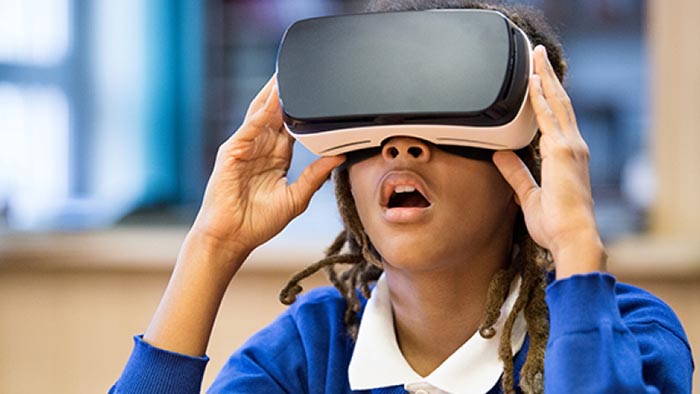
From K-12 Dive
By Anna Merod
May 9, 2022
Dive Brief:
Students experiencing a virtual field trip to Greenland through virtual reality headsets showed better understanding of the material and enjoyed it more than those who viewed the same content on video for a lesson on climate change, a small-scale study of European middle schoolers has found.
The study, published last month in Educational Psychology Review, analyzed a group of 102 students and found statistically significant evidence favoring the VR approach. The findings suggest immersive lessons can have long-term positive effects on learning, according to study authors and psychology professors Guido Makransky of the University of Copenhagen in Denmark and Richard Mayer of the University of California Santa Barbara.
Building off this research, there’s an opportunity to analyze the effects of the metaverse and virtual reality in education and how these factors can influence the social-emotional side of students, said Michael Young, an associate professor at the University of Connecticut’s Neag School of Education with expertise in cognition, instruction and learning technology.
Dive Insight:
Young said he wasn’t surprised by the study’s findings, adding they show VR and the metaverse can be helpful tools in education.
“I think it is very hopeful. Of course, it’s a very expensive technology still, so the downside is that you don’t want to exacerbate inequities,” he said.
The study also recognizes the value of VR implemented with good instructional design, Young said. VR should not be a simple substitution for a lesson, and the curriculum design using the technology is what matters more, he said. Both the video and VR instruction were just portions of a bigger lesson plan on climate change in this study.
“Sometimes [VR] canned programs don’t fit with the way you’re trying to teach,” Young said. That’s why it’s important to analyze how VR and strong lesson planning work together, he said.
Kathy Hirsh-Pasek, a psychology professor at Temple University, co-authored a Brookings Institution report on education and the metaverse in February that defines the metaverse as a “third space” combining the virtual and living worlds.
For her, the metaverse should not be a “one-stop shop” in education, and hybrid lessons should be considered. Hirsh-Pasek agrees with Young that if the metaverse is designed well in education, it will be “tremendously exciting.”
Young also sees the possibilities in VR to tap into educational opportunities encouraging collaboration in these emerging virtual spaces.
“I think VR gives us some potential to move our instruction away from highly individual stuff to more of those 21st century collaboration skills,” Young said.
Developers are still building metaverse technologies, which Hirsh-Pasek said she expects will be available in the near future. But the two limiting factors of the metaverse are the costs and the potential to create an equity issue of access for students, she added.
Even so, Hirsh-Pasek said this study focusing on passive versus active learning in technology provides a glimpse of hope for those looking to integrate the metaverse into education.
“We should all be hopeful and embrace the possibilities,” Hirsh-Pasek said. “This is not an issue of will it come, won’t it come? It’s an issue of can we do the most with it when it comes.”
Photo: Common Sense Media
Read this and other stories at K-12 Dive

